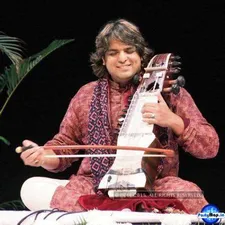


The musically gifted Kamal Sabri is the seventh generation of an eminent family of traditional musicians, son of legend sarangi Ustad Sabri Khan and is carrying forward his royal inheritance of the Sania gharana of Moradabad. In a candid conversation he gives insights about his musical journey. Excerpts
Q. How did you first become interested in playing the sarangi, and what drew you to this instrument specifically?
A. I was born in a musician’s family where Sarangi was the main instrument and has been playing for many generations. I am the seventh generation of our family serving Sarangi and Indian classical music. I used to see my father, my guru great Ustad Sabri Khan sahab and follow his teachings of travelling and performing all around the world.
Q. Can you describe the unique sound and capabilities of the Sarangi, and how do you use them in your music?
A. Sarangi is originated from the word Saurangi which means hundred colours, that is extremely versatile and considered to be the closest musical Instrument to human voice.
Sarangi can express multiple human emotions such as sadness, happiness, laziness through its sounds. This is used to play as a tradition on DD and AIR whenever any famous personality died, they would play Sarangi music on TV to pay homage. I decided to change this perception that people have and will work on music albums like Dance of the Desert, Sarangi Funk, Sarangi Redefined so that the other side of Sarangi can also be explored and revealed.
Q. What are the challenges in playing Sarangi, both technically and musically?
A. The playing and even learning of Sarangi is quite a painful process as you must go through much hardship, especially you have to be tough on your finger nails. Unlike other instruments, Sarangi is played with cuticles, the top part of finger nails from where the nailstarts to grow. Most of the musical instruments are played with the tip of the finger. It is also tough to get the control of the bow.
A Sarangi player also must enrich himself with a vast knowledge of music before they start to accompany vocalists of different gharana. They should be able to perform lehra(melody line) for Solo Tabla performance and Kathak dance recitals. The player also needs to have advance knowledge of Ragas in order to accompany pure classical vocalists.
Q. How do you approach inventiveness and composition on Sarangi and what is the role of tradition in your creative process?
A. When I do a solo classical Sarangi performance, the most important element of the performance is the raga. I have to decide which raga is to choose according to the time of performance and then the alaap of the raga has to be prepared according to its rules and law of recitation the raga. Then, the composition of the raga that is to set in a Taal. If you have not learnt music in a proper traditional way, you will not be able to perform it according to its laws. So firstly, one must have the knowledge of raga that one is going to perform, in a traditional way. Then one can show one’s own creativity according to the limitations that the raga allows.
Q. Will you discuss some of the collaborations and projects you have been involved in throughout your career, and how did they have influenced your music?
A. I stayed in Birmingham (UK) with my elder brother Ustad Sarvar Sabri (Tabla Maestro) for many years where I was a member of his famous world music band The SABRI ENSEMBLE. I learnt how to play with other great musicians. My brother taught me to play other instruments with western and other musical traditions.
Some of the greatest world music I have collaborated with are Ustad Nusrat Fateh Ali Khan sahab (Pakistan), Renato Martins (Brazil), Jan Garbarek (Norway), Sergio Cammariere (Italy), Jukka Tolonen (Finland), Boris Grebenschikov (Russia), Anna Maria Jopek (Poland), Premik Russel Tubbs (USA), John Sund (Denmark), Ustad Zakir Hussain sahab (India), bands like Massive Attack, One Giant Leap, orchestras like European Union Chamber Orchestra, Vienna Chamber Orchestra and U Srinivas (India). I have also recorded around 25 albums around the world.
Q. Can you share any forthcoming projects or performances that you are particularly excited about, and what audience can expect from your music in the coming years?
A. Recently I performed solo in UK where I was the only one representing Indian classical music. Now I am looking forward to perform in US in the biggest festival of Indian classical music. It gives me a lot of pleasure whenever I get opportunities to perform and present solo Sarangi recitals. There are many places in the world that have never experienced any solo Sarangi Concert and they get a lot of joy after coming and experiencing it.
Q. Finally, how do you inspire and connect with listeners through your Sarangi playing and what do you hope they experience from your performances?
A. My music is always to connect to the ultimate energy and to heal audiences with the power of music that has been gifted to me by the almighty. I get contented after listening to their wonderful experiences after my performance. When they share how positive they feel after listening to my concert and how they carry positive thoughts. This gives me immense pleasure.
Suman Doonga is an educationist and social worker with a passion to preserve and promote Indian art and culture.